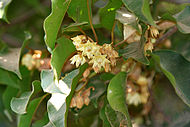Mimusops elengi
This articleneeds additional citations forverification.(October 2019) |
| Mimusops elengi | |
|---|---|

| |
| Scientific classification | |
| Kingdom: | Plantae |
| Clade: | Tracheophytes |
| Clade: | Angiosperms |
| Clade: | Eudicots |
| Clade: | Asterids |
| Order: | Ericales |
| Family: | Sapotaceae |
| Genus: | Mimusops |
| Species: | M. elengi
|
| Binomial name | |
| Mimusops elengi | |

Mimusops elengiis a medium-sized evergreen tree found in tropical forests in South Asia, Southeast Asia and northern Australia. English common names includeSpanish cherry,[2]medlar,[2]andbullet wood.[3]Its timber is valuable, the fruit is edible, and it is used in traditional medicine. As the trees give thick shade and flowers emit fragrance, it is a prized collection of gardens.[4]
Its flower is the provincial flower ofYala Province,Thailand,as well as the city flower ofAmpang Jaya,Selangor,Malaysia.[5][6]
Tree description[edit]




Bullet wood is an evergreen tree reaching a height of about 16 m (52 ft). It flowers in April, and fruiting occurs between June and October. The leaves are glossy, dark green, oval-shaped, 5–14 cm (2.0–5.5 in) long, and 2.5–6 cm (0.98–2.36 in) wide. The flowers are cream, hairy, and scented. The fruits are fleshy, range in color between yellow and brown, and contain a large brown seed. The pulp has a yellow color and it is edible. The bark of the tree is thick and appears dark brownish black or grayish black in colour, with striations and a few cracks on the surface. The tree may reach up to a height of 9–18 m (30–59 ft) with about 1 m (3 ft 3 in) in circumference.
Distribution[edit]
The plant is native to South and Southeast Asia, particularly the coastal areas of theIndian subcontinent,VietnamandMyanmar,as well asNorthern Australia.[7]It was introduced inChinain the 20th century, and is now cultivated in itssouth,as well as inTaiwan.[8]
Ayurvedic uses[edit]
The bark, flowers, fruits, and seeds ofBakula[9]are used in Ayurvedic medicine in which it is purported to beastringent,cooling,anthelmintic,tonic, andfebrifuge.It is mainly used for dental ailments such as bleeding gums,pyorrhea,dental caries,and loose teeth.[9][unreliable source?]
Other uses[edit]
- The flowers are sun dried and used to make floral infusions and as an addition to green tea in Thailand.
- The edible fruit is softly hairy becoming smooth, ovoid, bright red-orange when ripe.
- The wood is a luxurious wood that is extremely hard, strong and tough, and rich deep red in color. Theheartwoodis sharply defined from thesapwood.It works easily and takes a beautiful polish.Densityis 1008 kg per cubic meter.
References[edit]
- ^Barstow, M. (2019)."Mimusops elengi".IUCN Red List of Threatened Species.2019:e.T61964765A61964768.doi:10.2305/IUCN.UK.2019-1.RLTS.T61964765A61964768.en.Retrieved19 November2021.
- ^abBailey, L.H.; Bailey, E.Z.; the staff of the Liberty Hyde Bailey Hortorium. 1976.Hortus third: A concise dictionary of plants cultivated in the United States and Canada.Macmillan, New York.
- ^"Mimusops elengi".Biodiversity It is known as bakul in India.Retrieved14 October2013.
- ^"Maulsari".flowersofindia.Retrieved14 October2013.
- ^"ประวัติ จังหวัด ยะลา-Yala Province".Archived fromthe originalon 2013-11-09.Retrieved2013-03-25.
- ^"BUNGA RASMI MPAJ".Portal Rasmi MAJLIS PERBANDARAN AMPANG JAYA.12 August 2015.Retrieved15 November2019.
- ^"Mimusops elengiL. | Plants of the World Online | Kew Science ".Plants of the World Online.Retrieved2022-02-07.
- ^Trung Quốc nhiệt đới chủ yếu ngoại lai loại cây.ISBN9787541654701.
- ^ab"Bakula – an Indian plant with interesting properties".Natural Actives.Retrieved14 October2013.
Further reading[edit]
- Brock, J.,Top End Native Plants,1988.ISBN0-7316-0859-3
- IUCN Red List least concern species
- Mimusops
- Indomalayan realm flora
- Ericales of Australia
- Eudicots of Western Australia
- Flora of the Northern Territory
- Flora of Queensland
- Flora of tropical Asia
- Flora of New Caledonia
- Flora of Vanuatu
- Bushfood
- Plants described in 1753
- Taxa named by Carl Linnaeus
- Fruits originating in Asia

